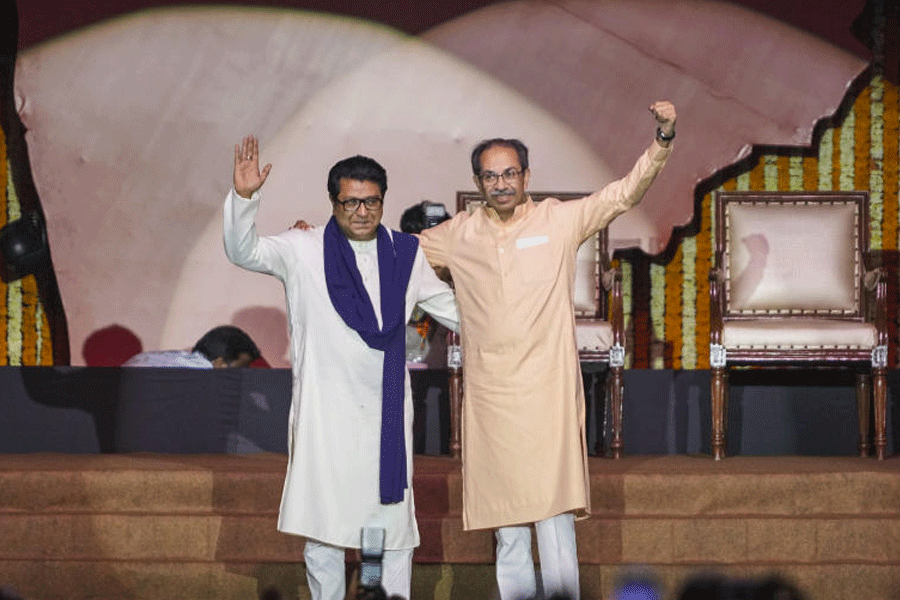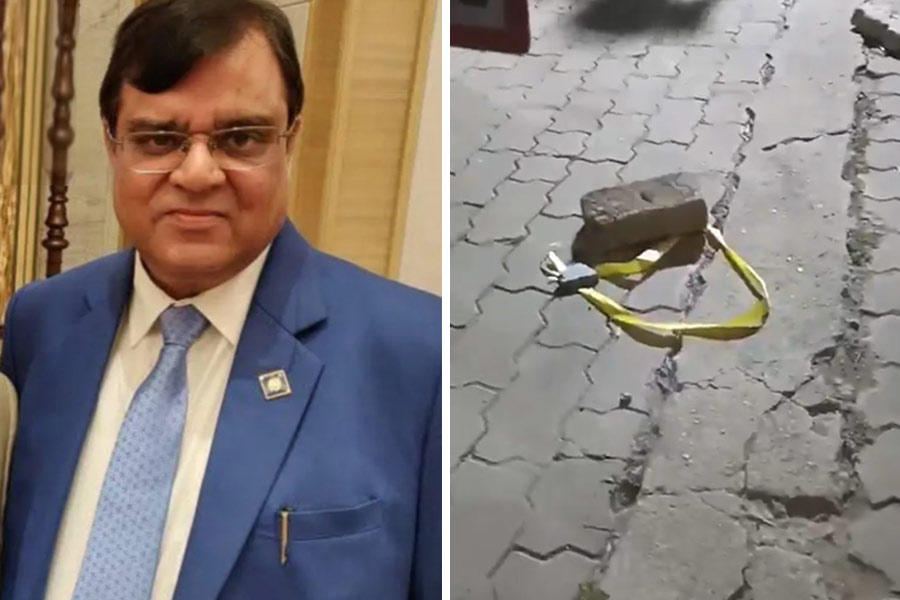 |
| Samir Aich’s (wearing cap) Nomadic Detours being inaugurated at CIMA Gallery on Friday |
Broken images, distorted contours, unique media, singular forms, a muted yet passionately emotive tonal palette.
In Nomadic Detours, Samir Aich’s first solo show at the CIMA Gallery that was jointly inaugurated by senior artists like Jogen Chowdhury, Lalu Prasad Shaw and Rabin Mondal on Friday evening, the 54-year-old takes viewers through a journey of his dynamic, politically aware work.
His art expresses intense emotion rather than being narrative. The CIMA show also marks a shift in style for the artist, known as much for his flair for creative experimentation as for his activist profile.
The display showcases Aich’s art over the past three years. Never a follower of “so-called abstraction”, his work at the turn of the millennium veered towards embodying the elemental. Playing around with tone, texture, form and even context, Aich, quite like his personal visual language at that point, was on the verge of a flux.
The stylistic shift towards minimalism began in 2005. His earlier work had included linear complexity and was busy, with an aggressive edge.
In his own words, Aich has since tried to “de-populate” his canvases. “I wanted to say less but express more,” he says. “I underwent changes in my personal life. I started working on really large canvases, but with reticence. In the process, my visual style and the presentation changed. Earlier, with a blank canvas in front of me, it was about thinking what to paint. Now, it’s all about what not to paint.”
Always a rebel with a cause — he was one of the prime movers of the protest walk against violence in Nandigram by Calcutta’s artist community in November 2007 — Aich’s trademark turbulent art now speaks in silent screams.
Nomadic Detours traces this process of flux and showcases Aich’s present visual style, which has perhaps toned down on the aggression, but is nevertheless turbulent in its emotive appeal and offers reality — primarily urban reality — without the frills. Red Earth, the first work that greets you at the entrance to the show, “represents Nandigram”, Aich says, but the violence is internalised.
It’s not just about the survivors of that violence, but their inner emotive state. Ironically, that state is presented in a stark ambience, without drama, without the overflow of emotions. Unlike his previous works, Aich’s lines flow to form figures, not get defragmented and shattered into explosions in physical space. The clutter of unnecessary details is cleared to present a neater whole.
Point this out to Aich and he smiles. “Modern-day weapons are very neat; there is no extra baggage. The designs are simple yet more effective,” he replies. “My lines may have softened, my canvases may have become neater, but I guess the intensity with which I want to express things that I see and feel has deepened.”
Indeed, muted earth reds and darkened greens are tones one would not have associated with Aich the artist in 2002, when he played around with the colour white. Serrated, open-jawed teeth lines, oblong body shapes, bandaged limbs and eternal themes of the hunter and the hunted are strewn around the wall space in Nomadic Detours. It is pain and the endurance thereof, frozen in frames. “If you live in a society and do not react to wrongs, you have no right to call yourself an artist,” says the artist, as an afterthought.
Aich explains that the exhibition is so named because of his rather wandering personality and his constant journey seeking new expression and, of course, his rejection of boundaries in the context of media.
In Seethe, Aich uses tea liquor for its specific tone; a work symbolic of the 2004 tsunami. In works like Silent Gale, Vividity and Remorse, there are actual thread structures over those whole canvases lined in acrylic — a T-shirt, stitches on a wound, a hanger, Gandhi glasses.
Those familiar with Aich’s earlier work would find references — ant-march hyphens, honeycomb structures — in some of these canvases.
The surprise? Large drawings in dry pastel and even the occasional watercolour. What next? “I won’t tell you,” he says, “I don’t know myself!”










